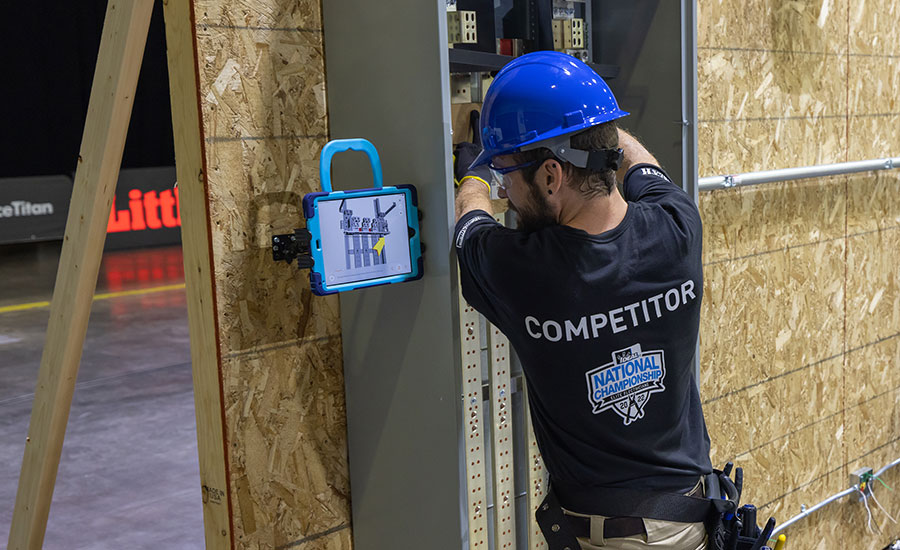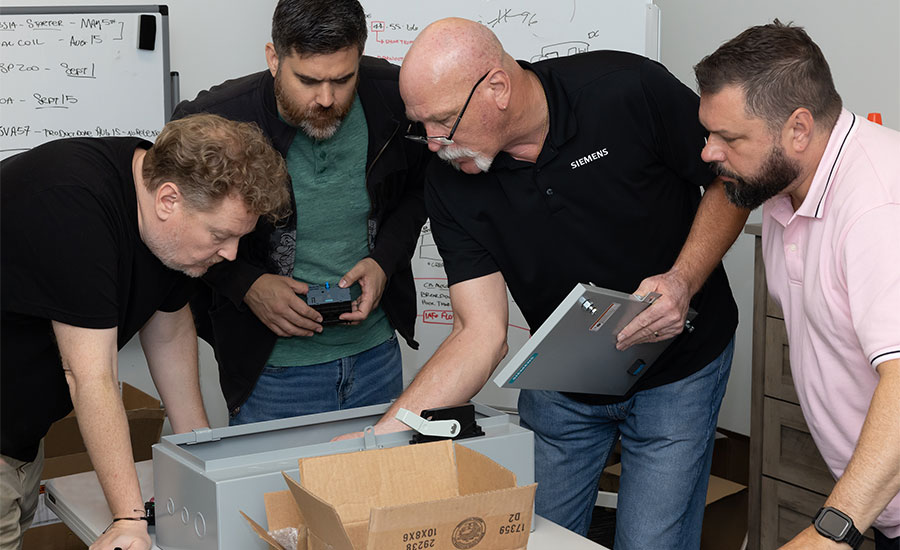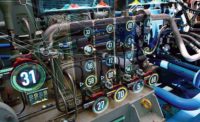According to a Deloitte study, 77 percent of manufacturers anticipate ongoing difficulties in attracting and retaining workers. Manufacturers are struggling to fill both entry-level and skilled positions. Experts estimate that 2.1 million manufacturing jobs will go unfilled in 2030.
To address this issue, Siemens has been actively exploring ways to improve training and expedite reskilling. For example, Siemens’ Electrical Products business unit (Siemens EP) recently created SIschool, an education program that partners with trade organizations, technical schools, community colleges, wholesale distributors, and electrical contracting firms. SIschool currently has more than 30 partners in 25 states. The goal of SIschool is to expose students, apprentices and instructors to electrical distribution equipment in the early stages of their careers.
Siemens EP also creates training for the company’s own internal manufacturing, sales and business development workforce. The effort addresses macro initiatives—such as workforce development and retention—and more specific needs, such as creating customized training tracks for individual partners.
The Siemens EP team focuses on enabling hands-on assembly and training for Siemens products. The team delivers this content through traditional channels, such as classroom instruction, textbooks and videos.
More recently, Siemens has designed training centered around virtual reality (VR) technology. Some training programs, materials and hands-on instruction for electrical contractors, specifying engineers, architects, designers and distributors are time-consuming and expensive. Instructors must travel to multiple locations. It’s difficult to ensure consistency of the information being shared, and it takes vast amounts of time to organize and facilitate the training sessions.
VR training solves these problems. VR allows people to assemble, install and learn about Siemens technology anywhere at any time. VR allows for hands-on training without the fear of failure or consequence. For example, with VR technology, students can install and assemble power distribution equipment and learn important safety protocols around arc flash mitigation.
“The problem is you can’t take all of this information to a job site, manufacturing plant or even a sales call,” says David Quatela, Siemens North American marketing manager.
Siemens EP partnered with software firm BILT Inc. to enable knowledge transfer and mobility by integrating training into users’ phones. Based in Grapevine, TX, BILT develops software that presents complex assembly and installation instructions in an interactive 3D mobile app that people can access anytime, anywhere. BILT converts a manufacturer’s instructions into a 3D interactive experience that gives users efficient, detailed, and visual guidance through every step of an installation, assembly, programming, maintenance or repair process.
“BILT takes CAD drawings from engineering and converts them into digital animations with step-by-step instructions of how to put together some of our more complex solutions,” says Quatela. “It demystifies our assembly and installation processes and makes everyone more efficient. BILT reduces labor time which gets us off the job site faster.”
The BILT partnership quickly transformed Siemens EP’s relationships with electrical distributors and contractors.

BILT converts a manufacturer’s instructions into a 3D interactive experience that gives users efficient, detailed, and visual guidance through every step of an installation, assembly, programming, maintenance or repair process. Photo courtesy BILT Inc.
Increasing Efficiency for Distributors
Over the past few years, the COVID-19 pandemic wreaked havoc on the global supply chain. Distributors who already faced longer lead times on fully assembled goods needed to find a faster, cheaper way to get products to their customers.
Siemens responded to this need by providing distributors with multiple components instead of fully assembled products. Distributors then put everything together according to customers’ varying needs. “As a distributor, there’s a huge value here because there is the potential to receive the product much quicker,” says Quatela.
Siemens sought to provide a standardized method for distributors to assemble the components. “We created a 3D experience with BILT to help distributors put together the product as a value-added service,” says Quatela. “Distributors are always looking for ways to differentiate themselves in the marketplace. This is a great way to do that.”
As the Siemens EP team was vetting the viability of the program, they approached a major distributor that was already assembling Siemens products using paper manuals. Each assembly took two employees more than two hours to complete, a total of more than four labor-hours.
Siemens and BILT team members went onsite to the distributor to test workers’ performance using BILT. The app’s digital work instructions shortened the assembly time on that product to less than 90 minutes and allowed a single employee to complete the job alone. BILT more than doubled efficiency for this install.
“That’s a good ROI for our distributors,” says Quatela.
The distributor requested that Siemens provide BILT 3D instructions for other products.
As a bonus for clients using the Net Promoter System (NPS), BILT can increase customer loyalty and improve scores. NPS is a market research metric that is based on a single survey question asking respondents to rate the likelihood that they would recommend a company, product or a service to a friend or colleague. NPS is a proprietary instrument developed by author Fred Reichheld, who owns the registered NPS trademark in conjunction with consulting firm Bain & Co. and software company NICE Satmetrix. Because faster delivery means happier contractors, “distributors using NPS have the potential to see their scores improve with BILT because they’re impacting their customers’ lives in a positive way,” says Quatela.

The Electrical Products business unit of Siemens uses digital work instruction software to train its own employees, as well as distributors and electricians. Photo courtesy BILT Inc.
Changing the Game for Contractors
Last year, Siemens was a sponsor at the IDEAL National Championship, which featured teams of electricians competing in timed installations. Apprentices partnered with master electricians to compete in the final event. The contest was to install the P5 Power Panel—the largest footprint distribution panel in the Siemens family. They provided each team an iPad with 3D instructions powered by the BILT app instead of traditional paper instructions.
In the pre-contest briefing, one of the pros, Roman Ryszewski of Pennsylvania, objected to using an app for the installation. He is a seasoned contractor and competitor who won the 2017 professional title.
“I’d never used [BILT]. I usually go by the paper instructions or figure it out,” says Ryszewski.
But after he began, he realized quickly that something was not right. “So, I turned [BILT] on and in the very first step I could rotate the image to the side view and understand how to put the parts together. Actually, the app was very helpful.”
“For him to need the app, with all his experience, it proves it’s obviously really helpful for when you’re just starting out,” says teammate Brady Wraalstad, a third-year apprentice from Wisconsin. “Everyone could navigate the app with ease, not just those of us who grew up with an iPad in our hands. The 3D modeling features are pretty cool, especially if it’s your first time or if you haven’t mastered the procedure yet.”
“The potential is limitless,” says pro competitor Alec Perkins, a journeyman from Iowa whose team placed second. “It’s unbelievable content. What you’re doing for the industry—especially for future generations of electricians—is paramount for the transfer of knowledge.”
“Hearing that validated everything Siemens and BILT are trying to achieve. And that is to move the industry forward,” says Quatela.
Investing in the Next Generation of Electricians
The next generation of electricians will consist of so-called “digital natives”—who grew up with video games, computers and smart phones and are accustomed to instant access to information. Rather than learning through textbooks or in-person instruction, this generation prefers the flexibility to process information through digital 3D images.
“BILT is absolutely the next step in the evolution of training,” says lab instructor Christie Peterson of the San Francisco Joint Apprenticeship & Training Committee for Local 6 of the International Brotherhood of Electrical Workers. She was one of the judges at the IDEAL Championships. Peterson says BILT’s adaptability and interactivity is ideal for apprentices.
“It’s clean. It’s clear. It’s good,” says Peterson. “Sometimes paper instructions are a blurry copy of a copy. BILT gives them the upper hand.”
She says electricians in training may not see some products in the field for a year or more, but if they had the opportunity to manipulate 3D animations in the classroom, then when they finally see them in the field, it will be easy for them to be successful.
“It’s possible trainees could install products without ever having touched the equipment in the classroom if they have familiarized themselves with the 3D instructions,” says Peterson. She thinks it’s “the next best thing” to a hands-on experience.
If we can make that electrician smarter, safer, and more employable—whether it’s someone with 40 years of experience or a year-one apprentice—then we’re doing our job.
“Everything our team tries to build is centered on teaching,” says Quatela. “Sure, there’s always a motivation for greater sales, revenue and profitability. But if we can make that electrician smarter, safer, and more employable—whether it’s someone with 40 years of experience or a year-one apprentice—then we’re doing our job.”
“Safer in terms of installation? Yes. Faster? I think BILT’s definitely going to increase productivity,” says Peterson. “The app helps you think ahead and plan for all the materials and tools you need for the job instead of making multiple trips.”
Looking ahead, Quatela says Siemens must listen to the individual needs of its customers and distributors and continue creating innovative content.
“With BILT, we’re just scratching the surface,” says Quatela. “We have many other products on our roadmap including getting BILT-based training into our manufacturing plants. Siemens is investing in this space to make both employees and customers smarter, safer, and more confident that they’re doing things right.”
For more information on digital work instructions, read these articles:
Visual Work Instructions and the Paperless Factory
Software Provides Work Instructions, Ensures Quality and Collects Data
Electronic Work Instructions Come of Age



